A side dish from the arid desert areas of Rajasthan, ker sangri subzi is made from dry vegetables i.e. ker berries and sangri pods that have been dehydrated and stored for use when fresh, along with basic Indian spices. Raisins and strips of dried mango add subtle sweet as well as tangy flavours. The sabzi is easy to make and has a unique taste.
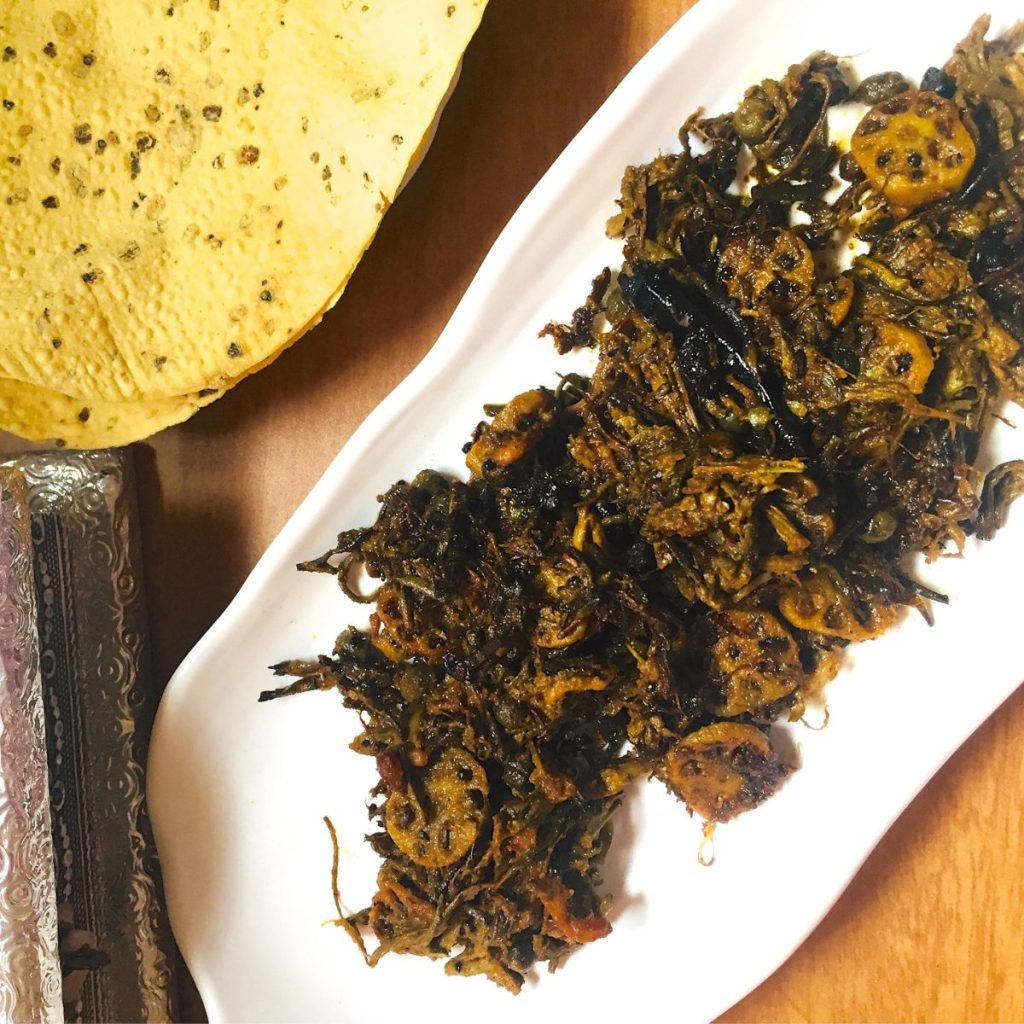
What Are Ker and Sangri?
Idly searching my cookbook collection and recipes for Rajasthani cuisine online, I came across this little gem. Ker Sangri ki sabzi. Both ker and sangri are from trees that grow in India's Thar desert area where green vegetation is sparse. The ker and khejri trees however, are able to survive and flourish in this difficult environment, thrusting their roots deep into the earth for precious water. Ker berries grow on the ker tree, and sangri are the pods or 'beans' from the khejri tree. The berries and pods grow only for a short period during the year, and hence they are plucked and dried for use during those times when no vegetables are available to add to the cooking pot. Here is an account I found interesting and informative, a traveler's tale on the kair sangri curry and you may like it too! It says that the dehydrated (uncooked) berries stay good and usable for about six years!
What Other Dishes Can Be Made?
When I started researching recipes, I found there were different ways of using these ingredients. Ker Sangri is usually made into a pickle (which sounds delicious from what I've read, but I haven't tasted this so far). Another popular dish using ker berries and sangri pods is the 5 ingredient 'Panchkuta Sabzi' made from dried ker, sangri, gunda (gum berry/ chorda myxa), kumat (seeds of the acacia fruit) and dry mango slices. I wanted to make this, but I was able to locate only ker and sangri online for purchase when I made this dish, and the ingredients were not available in local shops. They are usually easily found in shops in Rajasthan and those located near Marwari communities and nowadays most of them are available on online sites.
About This Recipe
I have broadly adapted a recipe from this little book I discovered, called Marwari Kitchen. The recipe instructed that the cooked ker and sangri be added to the tempering, however I have deviated from this process and instead sauteed the same. The recipe in the Marwari Kitchen specified Lotus root/ stem (I never know what to call it) or kamal kakdi as one of the ingredients, and this sounded interesting.
I have a sneaky feeling, in hindsight, that the recipe in the book I have referred to intended to use 'gunda' as the ingredients listed 'Lotus stem/ gunda', and perhaps mistook this to be the Hindi/ Rajasthani name for kamal kakdi. All my reading up has suggested, as I have explained above, that gunda actually refers to seeds of the acacia fruit, found in the desert region. The lotus root did taste very good when included in the sabzi, and added to the texture too, so I decided to go with this version, though I do not think that a traditional recipe for ker sangri would include lotus root. I would love to get this clarified by those of my readers who are familiar with Rajasthani cuisine!
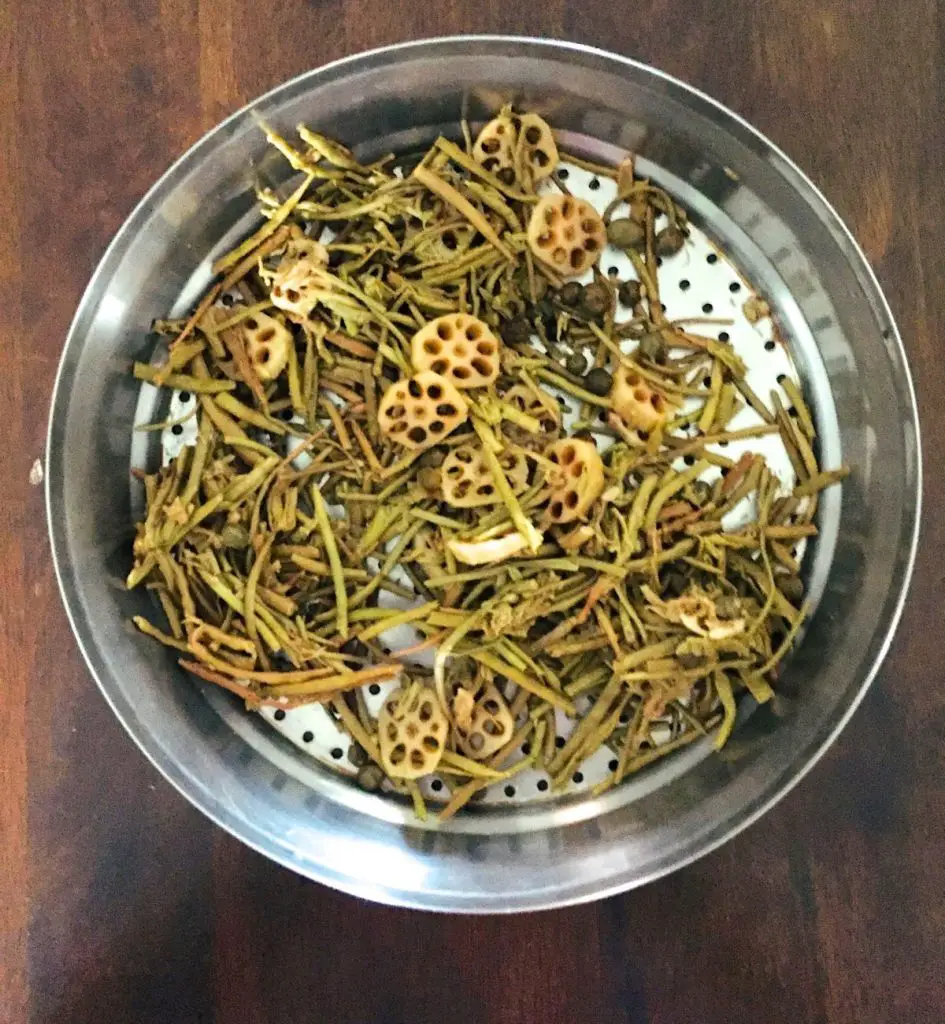
Ingredients Used
Keeping in mind that this dish is prepared at times when there are no fresh vegetables available in the desert regions, I have not included green chilies, coriander leaves etc. Only dried vegetables, dry spices and spice powders are used, along with a little curd.
The spices used are basic ones usually available in Indian kitchens: mustard seeds (rai), cumin seeds (jeera), fennel seeds (saunf), carom (ajwain), dry mango, raisins, and spice powders like chili, asafoetida, mango powder (amchoor), turmeric (haldi) and coriander (dhania) powders. Mustard powder is optional and will enhance the flavours. The fresh Lotus root as I said earlier, probably has no business being here in a traditional recipe, but does add to the texture.
Other Indian Vegetable Sabzi/ Curry Recipes
"Recipe"
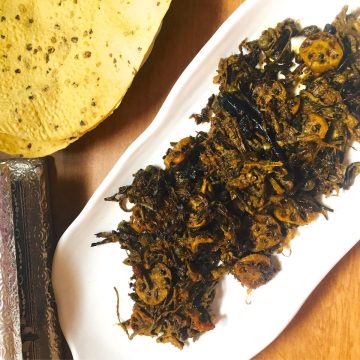
Ker Sangri / Tradtional Rajasthani Subzi
Equipment
- Pressure Cooker
- Frying pan
- Colander
Ingredients
For Soaking Overnight and Pressure Cooking
- 3 cups Dry Sangri Beans (100 grams) soaked, rinsed, drained
- 1 teaspoon Turmeric Powder
- 1 teaspoon Sunflower oil or other vegetable oil
- 1 teaspoon Salt
- 2.5 tablespoons Dry Ker / Kari/ Kair Berries (25 grams) soaked, rinsed, drained
- ¼ cup Lotus root sliced
- Water (for soaking, rinsing) As per instructions below
For Making Ker Sangri Sabzi
- 3 tablespoons Sunflower Oil or other mild flavoured vegetable oil
- 1 teaspoon Rai /Mustard seeds
- 1 teaspoon Jeera / Cumin Seeds
- 1 teaspoon Saunf / Fennel Seeds
- ¼ teaspoon Ajwain / Carom Seeds
- 3 -4 Dry Red Chilies
- ¼ teaspoon Hing / Asafoetida Powder
- 3 tablespoons Dry Raw Mango strips
- ½ teaspoon Haldi Turmeric Powder
- 1.5 teaspoons Kashmiri Red Chili Powder or Degchi Mirch
- 2 teaspoons Dhania / Coriander Powder
- 1 teaspoon Amchur / Dry Mango Powder
- 1 teaspoon Mustard Powder optional
- 2 tablespoon Curd / Plain yogurt
- 2 teaspoons Raisins
- ¼ teaspoon Salt or to taste
Instructions
To Soak Ingredients Overnight
- Rinse dry Sangri beans, drain and add water to about 1" above the surface of the sangri. Add turmeric powder, oil and salt as listed in ingredients above, and stir. Soak overnight or for about 8 hours
- Rinse the Ker berries You will find a sooty grey dust-like material coming from the Ker. Drain, and soak overnight (or for about 8 hours) with water about ½" above the surface of the Ker berries. Soak ker and sangri are to be soaked separately as above.
To Pressure Cook Ker Sangri and Lotus Root (if using)
- Take one long Lotus root/ stem. Peel it and slice into rounds. As you slice, Immediately place the slices in a bowl of water and keep them soaked till done as they get easily discoloured.
- Drain the soaked ker berries and sangri beans and rinse a few times. Drain and place in a pressure cooker. Add drained lotus root slices.Add sufficient water to cover the surface of the ker, sangri. Pressure cook for 2 whistles. Let the cooker cool and release pressure on its own.
Preparation:
- Once the pressure cooker has let off steam, open and drain the contents. Rinse and drain once more. Set aside till required.Slice the mango strips into small thin pieces Measure and keep all ingredients ready for making the ker sangri sabzi
To Make Ker Sangri Sabzi
- Heat oil in a pan. Keeping the heat on low, add mustard seeds and once they crackle, add cumin/ jeera seeds.Add Fennel/ saunf seeds and Carrom/ ajwain seeds.Remove the stalks from the red chilies and saute for a few seconds, turning the chilies in the pan so that both sides are fried.Add Asafoetida/ hing powder. Add the raw mango slices.Saute for 2 minutes, stirring frequently.
- Add the cooked and drained ker, sangri, lotus root. Stir
- Keeping the heat on low, add turmeric powder, kashmiri red chili powder / degchi mirch, coriander powder, mango powder / amchur, mustard powder (if using) and stir well. Saute for 1 minute
- Beat the curd with a whisk or fork and add. Stir it into the sauteed masala.Add Raisins and salt. StirSaute and let the sabzi cook for 7-8 minutes, stirring frequently as the masala powders tend to stick to the bottom of the pan and char. Scrape any masala you find sticking to the pan.No water is to be added while cooking the ker sangri.Remove from the heat, transferring the sabzi to a serving vessel.Serve with rice and dal and roti. It tastes amazing with poori too.



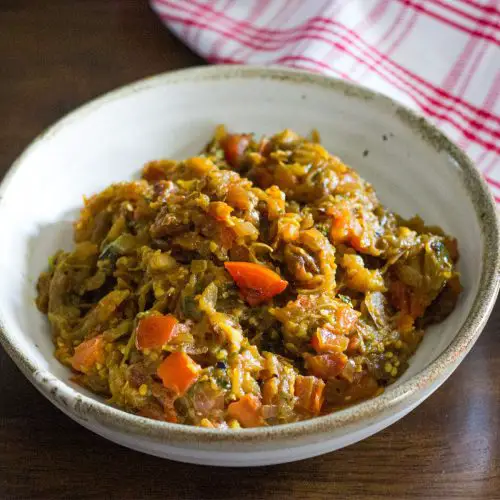
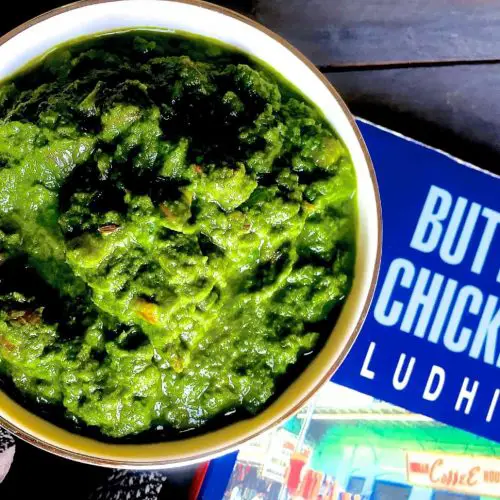
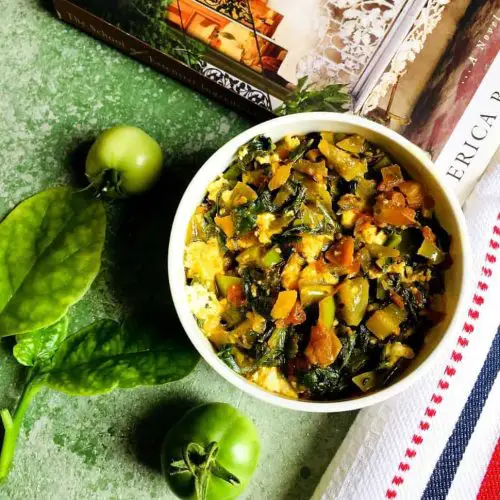
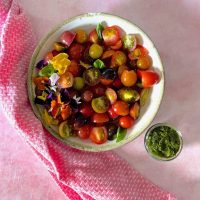


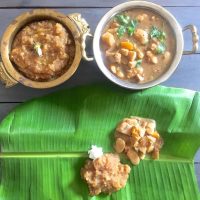
Batter Up With Sujata says
Never tasted it. Ker sangri curd and the spices you have used sounds delicious. Always loved your detailed write up about ingredients and recipes of different cuisine. I will surely try it on my next Rajasthan visit.
Seema Doraiswamy Sriram says
Sujata, your dedication to go to the deepest extent of clarification is so valuable. I loved the way you have dug out the difference between the different gunta. On a different note this recipe looks so exciting and will rely on this if I ever find these ingredients here.
Sujata Shukla says
That's so nice of you, Seema, to go through the post and tell me what you liked! This is an interesting subzi, very different in taste from what I usually make. The ingredients are not easy to get though!
Vasusvegkitchen says
Ker Sangiri looks tasty and sounds very interesting. This is new recipe that I never heard, would love to taste it, d't know whether it's available here in chennai. I even never tasted lotus stem too, very well explained the recipe di👌
Sujata Shukla says
Thank you so much! I got the ingredients online, and have given a link in the post, to the brand I tried out!
namscorner18 says
Wow such a interesting recipe from Rajasthani cuisine. Hats off to you to try something different from usual and also letting us know about these wonderful things. Sabzi looks so delicious.
Sujata Shukla says
Thank you so much. I try to keep my blog interesting!
Ashima says
I've had ker sangri so many times in Jodhpur and Jaipur but we don't find Ker or Sangri here 🙁 Going home soon and I can't wait to try this. You've really put in a lot of effort in making the dish authentic. Thanks for sharing!
Sujata Shukla says
More and more ingredients are beginning to be available online now, and this helps when we want to try out different recipes, isn't it!
poonampagar says
This is an entirely new dish to me . Loved the way you have given minute details of the recipe, right from soaking to cleaning and cooking the subji. Would definitely love to try out this unique and traditional Rajasthani dish.
Sujata Shukla says
Thank you Poonam! I thought details would be helpful to users, as I had a lot of doubts myself, while preparing the subzi!
Renu Agrawal Dongre says
Wonderful read about how ker sangri originated or why it is very common in Rajasthan. This is a must in marwari weddings. Yes pickles are also made using it and I love ker ka achar. The sabji looks quite delicious and bursting full of flavours. You have done 100 percent justice to the dish.
Sujata Shukla says
Thank you so much, Renu! I have yet to try the pickle, must do that too!
mayurisjikoni says
An interesting read Sujata about both Ker and Sangri. I'd tasted a dry preparation of both in a restaurant in Jaipur some years back and found it really interesting. I cannot remember the name of the cookery show but Chef Kunal Kapur went to villages to learn out to make authentic pickles and Ker sangri gunda was one of them. Gujaratis tend to use gundas a lot for pickles.
Sujata Shukla says
Thank you Mayuri. I've yet to try the pickle form of ker sangri. Im sure it would be very tasty. Must try.
jayashreetrao says
This looks tasty and something different for me. I need to try it sometime soon. Thanks for this recipe.
Sujata Shukla says
Thank you, Jayashree. It was new for me too!
FoodTrails says
It's been ages since I had ker sangri.. loved going through your post that brought back memories of my stay in Rajasthan, where college friends used to bring this traditional subzi for boarders. Very nicely explained recipe with steps on how clean and use it.. so helpful for someone who will be trying out this for the first time.
Sujata Shukla says
Thank you so much, Swaty! As I was making it for the first time, I had to learn and thought others may find these tips useful too!
sharanya palanisshami says
I was happy to be partnered with you sujatha. You took lot of effort in making this recipe.... I am proud of your effort . Thank you for making this traditional curry .....
Sujata Shukla says
Thank you Sharanya! It was nice being your partner for this theme! And thanks for the ingredients which made it easy for me to pick the recipe to use them in!
themadscientistskitchen says
Just recently at the BM meet I tasted ker sangri. It tasted good but I am not sure about my family liking it. I always wanted to try making ker sangri but sourcing it online did not occur to me. Thanks for the tip.
As for the recipe I like the idea of using lotus stem. Now I am definitely trying the recipe out.
Sujata Shukla says
Thank you Archana! It tasted very good with poori!
Priya says
Ooh...its been such a long time time that in had ker sangri...after reading your description.. want to have it right away..lovely share
Sujata Shukla says
Thank you, Priya!
sizzlingtastebuds says
very interesting to read the take on the Ker Sangri. this is one of hubby's fav dishes from Rajasthan and my Marwari neighbour makes sure to send me a batch of this every time she makes it. Now I have an authentic recipe on ur blog to refer, Akka !
Sujata Shukla says
Thank you so much Kalyani! I do hope you try it out and let me know how it was. The lotus root is probably not part of the authentic recipe though, as I have explained in my post.
shobhakeshwani says
I love this sabzi.. tastes so yummy specially when made with mustard oil. Divine !
Sujata Shukla says
Thank you Shobha. First time for me, and it was great! Such a different taste!
The Girl Next Door says
Wow, the Ker Sangri looks and sounds absolutely delicious! I love these unusual yet traditional recipes that you come up with. Can't wait to order my stash of ker sangri online and try this out at home. 🙂
Sujata Shukla says
Thank you Priya! I'm learning so much about traditional Indian recipes!
Rafeeda - The Big Sweet Tooth says
Very very interesting! I like how you always want to explore unknown territories, it terrifies me still... thanks to my family... hehe... I am not sure where I can find this vegetable. Looks and sounds very intriguing...
Sujata Shukla says
Thank you Rafeeda! I do like experimenting with ingredients I have not used before. I found these on a site called spiceplatter.com, however delivery is only in India, so far as I can see. Amazon also has these items.